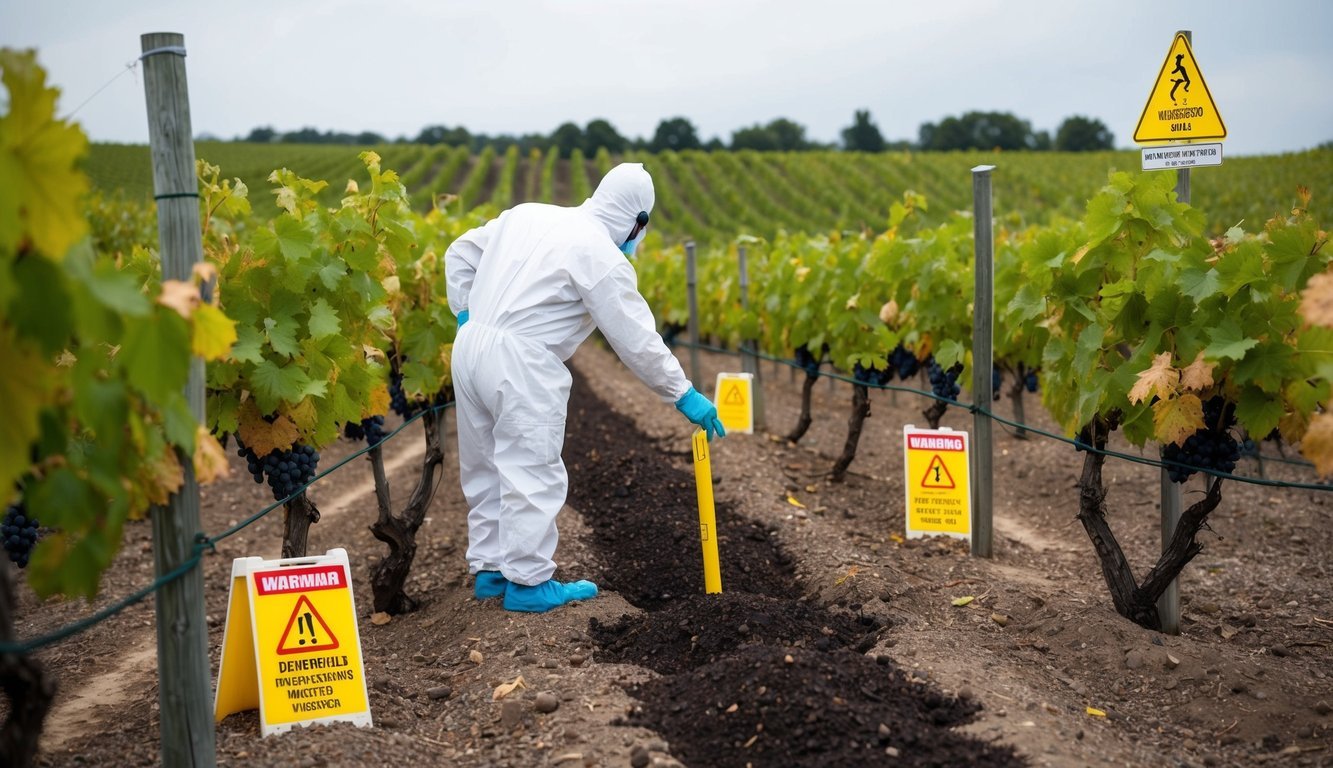PsychNewsDaily Publishers
100 Summit Drive
Burlington, MA, 01803
Telephone: (320) 349-2484
PsychNewsDaily Publishers
100 Summit Drive
Burlington, MA, 01803
Telephone: (320) 349-2484
Wine can contain unlisted additives like sulfites, hidden sugars, and contaminants such as arsenic and glyphosate, potentially impacting health when consumed without caution.

Many people enjoy a glass of wine to relax and socialize. While wine can have some health benefits in moderation, hidden dangers could be lurking.

From additives to contaminants, the wine industry can hold surprises that may affect drinkers. Understanding what might lurk in their favorite bottles is key to enjoying wine without compromising health.

Many wines contain chemicals that are not listed on the label. This can be surprising for consumers who believe they are enjoying a natural product.
Some common additives include sulfites, used to preserve freshness, and fining agents, which help clarify the wine. These additives might not be harmful for everyone, but some people are sensitive to them.
Certain wines may also contain other ingredients, like GMO yeast. This raises questions for those concerned about food sources and additives in their drinks.
Natural wines aim to limit these additives. They often use fewer chemicals and focus on traditional production methods. Consumers interested in purity may want to explore these options for peace of mind.

Many people believe that sulfites in wine cause headaches. This myth often leads to unfair blame on sulfites for unpleasant effects after drinking wine.
Sulfites are used in winemaking to prevent spoilage and oxidation. Almost all wines contain them, but the levels are usually low and safe for most people.
Studies have shown that headaches may be linked to other factors, such as histamines and tannins in wine. These compounds can affect certain individuals more than sulfites.
European wine regulations limit the amount of sulfites allowed, ensuring that they stay within safe levels. Most people can enjoy wine without worrying about sulfites causing headaches.

Many people enjoy wine, but hidden sugars can be a concern. Some wines contain more sugar than expected. This can make a drink taste sweeter while adding extra calories.
Consuming too much sugar can lead to weight gain and health issues. It may increase the risk of conditions like obesity, diabetes, and heart disease. These problems can affect anyone, especially those who drink wine regularly.
Wine labels often do not show sugar content clearly. This makes it hard for consumers to know how much sugar they are drinking.
When enjoying wine, it is wise to be mindful of hidden sugars. Choosing dry wines may help reduce sugar intake. This can be a simple way to protect health while still enjoying a favorite drink.

Some wines may contain arsenic, a substance that can pose health risks. Recent studies found that many U.S. red wines have arsenic levels that exceed drinking water standards set by the EPA. This can be concerning for regular wine drinkers.
A study showed that up to 98 percent of tested red wines contained higher arsenic levels than allowed in drinking water. While some may think the levels are low enough to be safe, others worry about long-term effects.
In 2015, certain popular wine brands were identified as having dangerously high arsenic levels. Some samples had levels four to five times above what is considered safe. This raised alarms among health experts and consumers alike.
The issue has led to lawsuits and ongoing debates about wine safety. Many are now more cautious about the wines they choose and may seek alternatives that are tested for harmful substances.

Many people may not know that glyphosate can be found in wines. This is surprising since glyphosate is mainly known as an herbicide used in farming.
Recent studies have detected glyphosate in numerous wines, including those from California. This raises questions about how much of the chemical could be in the products they enjoy.
Glyphosate is the active ingredient in Roundup, a popular weed killer. Its presence in beverages is concerning, especially given the health risks linked to this chemical.
Some researchers suggest that glyphosate can affect gut health and even brain function. It is important for consumers to be aware of this issue when choosing wines.

Many wines today have higher alcohol content than in the past. This change can affect how the body processes alcohol. Higher alcohol levels mean that drinking less wine can lead to higher blood alcohol levels.
As the alcohol content rises, the risks associated with drinking also increase. For instance, this can lead to a greater chance of health problems like liver disease and certain cancers. Alcohol breaks down into acetaldehyde, which is a known carcinogen.
Consumers should pay attention to the alcohol percentage on wine labels. Choosing lower-alcohol wines can be a smarter option for those looking to enjoy wine without too much risk.
Finding wines with lower alcohol content is becoming easier, as many wineries now offer these choices. It may take a little more time in the store, but it can greatly benefit health.

Resveratrol is a compound found in some plants, including grapes. It helps plants fight off threats like bacteria and fungi. Many people believe it may also offer health benefits to humans.
Some studies suggest that resveratrol can lower the risk of heart disease. Yet, other research shows that it may not provide the protection many expect. This has caused some debate among experts.
Red wine is often praised for its resveratrol content, linking it to heart health. Still, scientists say more research is needed to fully understand its effects.
While resveratrol might have some positive qualities, it should not be seen as a miracle cure. Enjoying wine in moderation can be part of a balanced lifestyle, but relying solely on it for health benefits may not be wise.

Lead can be a hidden danger in some wines. While most wines are safe, certain factors put them at risk. For example, lead can come from old glassware, like crystal decanters. Over time, lead can leach into the wine stored inside.
Another source of lead is contamination from soil or water in vineyards. Some regions may have higher levels of lead due to past industrial activities. This can affect the grapes grown there.
Certain wines, especially those from older practices, might have lead problems. It’s important for consumers to be aware of the risks associated with lead exposure. Lead is harmful to health, especially for vulnerable groups like children and pregnant women.
To protect health, it’s wise to choose wines from reputable sources. Checking for certifications or labels can help ensure safety.

Many wine labels can be tricky. They often use terms that sound healthy or natural but don’t tell the whole story. For example, words like “natural flavors” can hide artificial ingredients.
Wineries might not have to disclose all the chemicals used in the production process. This means that consumers may not know if their favorite wine has added sugars, sulfites, or other additives.
Some labels may also imply that a wine is organic or free from pesticides without meeting the strict standards needed. This can lead people to believe they are making healthier choices.
Reading labels carefully is important, as misleading information may affect health. Knowing what is in a bottle can help consumers make better choices for themselves and their families.

Many people enjoy a glass of wine with dinner or while relaxing. It’s important to know how this can affect weight.
Research shows that light to moderate wine drinking does not usually cause weight gain. This is a relief for those who enjoy wine in small amounts.
However, drinking heavily can lead to extra pounds over time. When someone drinks often, those calories can add up quickly.
A regular glass of wine might fit into a healthy diet, but moderation is key.
Those who rely on wine for health benefits should be cautious. While some benefits exist, using it as a primary health source is not recommended.
Being aware of what wine can add to daily calories can help. It is wise to enjoy wine while keeping an eye on overall consumption.

Certain wines, especially those with high alcohol content, can raise blood pressure. Drinking too much alcohol may lead to heart issues and increase the risk of developing hypertension.
Some studies have suggested that excessive red wine intake can cause irregular heartbeats. These changes can affect overall heart health and lead to serious problems over time.
Interestingly, non-alcoholic red wine might actually help lower blood pressure. Research has indicated that it may be more beneficial than regular red wine in this regard.
People should consider their wine consumption and how it affects their health. Moderation is key to enjoying wine without raising blood pressure.

Many people believe that red wine can boost heart health. Recent studies suggest that moderate consumption may lower the risk of cardiovascular disease.
However, experts are cautious about these claims. They highlight that the benefits may not apply to everyone. Results can vary based on individual health and lifestyle.
Some research indicates that alcohol, including wine, can have negative effects. For certain people, drinking wine might even increase health risks over time.
Further investigation is needed to fully understand these heart health claims. Seeking professional advice is wise for anyone considering wine for health benefits.
Always remember that moderation is key. Drinking too much can lead to other health issues.

Wine can contain several additives that enhance flavor, stability, and appearance. While some are safe, others can be harmful. It is essential to know what these additives are and how they might affect health.
Several common additives are used in wine production. Here are a few:
Sulfur Dioxide (SO2): Winemakers use it as a preservative. It helps prevent spoilage and oxidation. Some people may have allergic reactions to it.
Fining Agents: These include substances like egg whites or fish bladders that clarify wine. Most of these are removed before bottling, but traces may remain.
Sugar: Sometimes, winemakers add sugar to balance acidity or enhance sweetness. Excessive consumption could lead to health concerns, including increased calories.
Acids: Winemakers add acids to adjust pH levels to improve taste and stability. Common acids include tartaric acid and citric acid.
Knowing about these additives can help consumers make better choices regarding wine selection.
The impact of wine additives varies. Some, like sulfur dioxide, can cause headaches or allergic reactions in sensitive individuals.
On the other hand, fining agents usually do not affect most people since they are typically filtered out. However, those with specific allergies should remain cautious.
Additives like artificial colors and sweeteners may pose additional risks. Long-term exposure could lead to various health problems.
Choosing organic or natural wines might reduce exposure to harmful additives. This option often contains fewer chemicals and may be healthier.

Wine production involves various practices that can affect the quality and safety of the final product. Understanding these practices helps consumers make informed choices.
Many vineyards use pesticides to protect grapevines from pests and diseases. Some common pesticides include glyphosate and other chemicals. These substances can remain on the grapes and may not be fully removed during processing.
Consumers might want to know that some wines can contain trace amounts of these chemicals. Organic wines, on the other hand, typically use fewer synthetic pesticides, focusing on natural solutions.
Buying wines labeled as “organic” or “biodynamic” can reduce exposure to harmful substances found in conventional wines. This choice supports healthier vine-growing methods.
Sulfites are compounds that winemakers add to wine as preservatives to maintain freshness and prevent spoilage. Many wines—especially those with added sulfites—can cause reactions in sensitive individuals, leading to headaches or allergic reactions.
It’s essential to check wine labels, as sulfites are not always listed clearly. Natural wines often have lower sulfite levels.
Some people prefer wines without added sulfites for a cleaner taste. Making careful selections can help consumers find options that align with their health concerns.
Many people have questions about how wine can affect health. Understanding these concerns can help make informed choices about wine consumption.
Yes, some wines contain hidden ingredients that may affect health. Additives like pesticides, such as glyphosate, can occasionally be present in wine. Consumers should pay attention to what is in the wine they are drinking.
Drinking wine regularly can pose risks, especially related to its ingredients. Some wines have high levels of sugar and sulfites, which may lead to headaches or allergic reactions. It’s important to monitor personal responses to different types of wine.
Moderate wine consumption can be part of a healthy lifestyle for some. However, excessive drinking may lead to issues like high blood pressure and liver problems. Balance and moderation are key to maintaining wellbeing.
Yes, consumers should be cautious about added sulfites and hidden sugars. Some wines also contain arsenic, which can be harmful in large amounts. Checking labels and doing research can help avoid unwanted ingredients.
Drinking in moderation is vital for health. It’s also wise to choose organic or natural wines, which often have fewer additives. Staying hydrated with water while enjoying wine can help reduce the impact of alcohol.
Look for red wines that are low in sugar and sulfites. Wines made from organic grapes may have fewer harmful chemicals. Research brands with a reputation for quality and transparency to help you choose heart-healthy options.